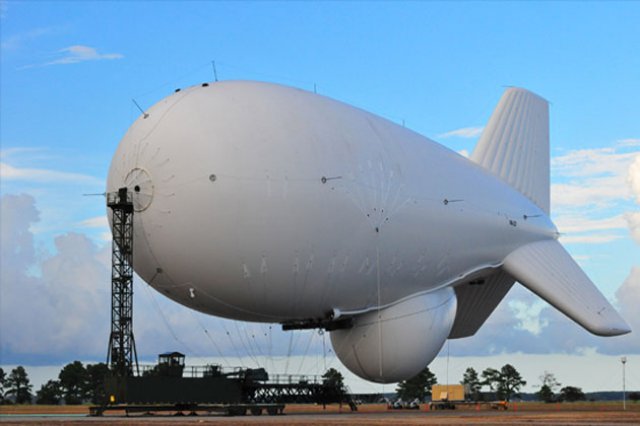A recent demonstration proved that operators can observe surface moving targets — including a terrorist role-player planting an improvised explosive device — in real time using a Raytheon Company MTS-B Multi-Spectral Targeting System mounted on the JLENS.
During the Raytheon-funded demonstration, and despite heavy smoke from recent, naturally-occurring forest fires, an MTS-B electro-optical/infrared (EO/IR) sensor mounted on a JLENS surveillance aerostat tracked numerous targets with the IR sensor. Video from the MTS-B was passed through the aerostat’s tether, enabling operators to watch live feed of trucks, trains and cars from dozens of miles away. While the MTS-B visually tracked targets, the JLENS simultaneously tracked surface targets with its integrated radar system, demonstrating the potential to integrate the JLENS radar and EO/IR payloads.
As part of the demonstration, operators also used the MTS-B’s EO sensor to watch Raytheon employees simulate planting a roadside improvised explosive device.
“The JLENS integrated fire-control radar and 360-degree surveillance radar already gives the warfighter the capability to detect and engage surface and airborne threats like swarming boats and anti-ship cruise missiles,” said Dave Gulla, Vice-President of Global Integrated Sensors for Raytheon’s Integrated Defense Systems business. “Integrating the proven MTS-B on JLENS makes JLENS multi-mission capable and enables the warfighter to better defend the battlespace and protect critical infrastructure and waterways.”
JLENS, an elevated, persistent over-the-horizon sensor system, uses a powerful integrated radar system to detect, track and target a variety of threats. This capability better enables commanders to defend against threats, including hostile cruise missiles; low-flying manned and unmanned aircraft; and moving surface vehicles such as boats, mobile missile launchers, automobiles, trucks and tanks. JLENS also provides ascent phase detection of tactical ballistic missiles and large-caliber rockets.
- A JLENS system, referred to as an orbit, consists of two tethered, 74-meter aerostats connected to mobile mooring stations and communications and processing groups.
- The aerostats fly as high as 10,000 feet, can remain aloft and operational for up to 30 days, and can detect and target threats up to 550 km (340 statute miles) away.
- One aerostat carries a 360-degree surveillance radar, while the other carries a fire control radar.
The MTS-B is a multiuse, electro-optical/infrared (EO/IR), laser detecting-ranging-tracking set developed and produced for use in military systems. Based on a state-of-the-art digital architecture, this advanced EO/IR system provides long-range surveillance, target acquisition, tracking, range-finding and laser designation for the HELLFIRE missile and all tri-service and NATO laser-guided munitions.Raytheon Company, with 2011 sales of $25 billion and 71,000 employees worldwide, is a technology and innovation leader specializing in defense, homeland security and other government markets throughout the world. With a history of innovation spanning 90 years, Raytheon provides state-of-the-art electronics, mission systems integration and other capabilities in the areas of sensing; effects; and command, control, communications and intelligence systems, as well as a broad range of mission support services. Raytheon is headquartered in Waltham, Mass.
Source: Press Release

